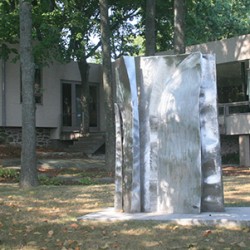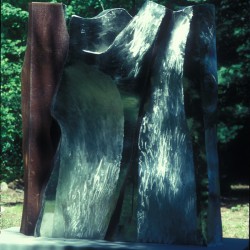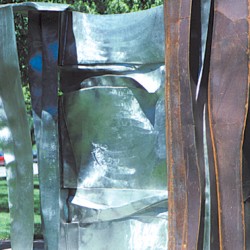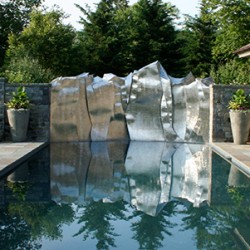- Serac IV
- Serac V
- Serac VI: Moulin Vert
- Serac VII: Chalice
- Serac VIII: Acies
(Louis Agassiz, the founder of glaciology, was a francophone swiss, and thus many of the terms used in glaciology– like sérac– are from French. A sérac is a column of ice detached or semi detached from the parent glacier. These usually occur where the glacier is moving over irregular terain, or at a tidewater terminus where calving is taking place.)
More InformationIn these pieces, references to man/nature relationships are intended to be interwoven, ambiguous, and tangled, so that one-to-one symbolic relationships do not exist. Instead, some of the predominate elements.
METAL: The materials in these pieces are limited to bronze, Cor-Ten steel (with the appearance of iron), stainless steel, and aluminum, in ascending historical order. Bronze was mankind’s first metal, having been in use for 10,000 years, or for the entire span of human civilization. Aluminum, on the other hand, has had scarcely a century of commercial use. It is a child of the industrial revolution, a period marked by our species’ unbridled battery upon this planet and its biosphere. There is some irony in this, since of the metals used in these pieces, aluminum is capable of some of the subtlest effects of light.
WELDING: With the exception of forge welding, which has always had a very limited application, welding has a history restricted to this century. It has been pivotal in technological ‘progress’, and any use of welding in a metaphorical context must recognize, and draw on, these implications.
SURFACE AND SKIN: Despite an appearance of massiveness, these pieces are hollow and light, being made of sheet stock of 14ga- 18ga (0.078″- 0.048″). Thinness of stock is considered a virtue, and is limited by weldability. As progress is made in available, practical technologies, skin thickness can be reduced still further. Also, the visible surfaces are not the parent metal itself, but a thin oxide film. In the case of Cor-Ten, it is fairly thick and velvety, but with aluminum and stainless it is extremely thin, measuring only a few angstroms. In a sense, these films are what constitutes the piece, since they are exclusively what is seen, the parent metal being only a vehicle, somewhat parallel to the cloth supporting the paint in a traditional canvas. The ‘less is more’ thinking inherent in this technical approach (not to be confused to the original ‘less is more’ statement which concerned aesthetics and architecture) has parallels for and in human industry, and in this context, has much to do with mankind’s attitudes towards this planet, and his and its survival.
ICE: Ice is not only one of the most provocative phenomena in the natural world, it is also one of the most extensive: it is sole lord of one ocean and two continents, as well as many other domains. Ice is commonly an inconvenience and a threat to mankind and even his grandest works, and can be thought of in some circumstances as very much an animate adversary. Glaciers exude a powerful sense of life, with movement and voice, presence and majesty unforgettable to any receptive witness. Floes and bergs, with their bewildering variety of suggestive shapes, can seem members of an animal kingdom. The coupling of the extent and variety of ice, and its being made of nothing more than water, cold, and light, offers great potential for its use in a demanding metaphorical role. And, on another level, it is not to be overlooked that ice, in all its forms, is always stunningly beautiful.
ROCK: Any perception of the purely formal qualities of rock is of necessity colored by the inevitable association with ‘mother earth’, and all that is thus implied. However, with only a small stretch, many of the implications also apply to glacier ice. Ice is a mineral, and rock, like ice, is a slow-motion plastic event. Despite this, rock is perceived as ‘permanent’, and has been used as such by every civilization that had the ability to do so. Use of stone, and skill therein, is one of the benchmarks of history’s assessment of cultures. Any metaphorical reference to rock must recognize permanence as a purely human, and relative, concept.
TIME: Any reference to glacier ice or rock is necessarily in four dimensions, time being the fourth. Ice at the base of the Antarctic cap can be as old as 500,000 years, and rocks even older. Thus, any vertical slice through these materials is of necessity a descent through time as well as space. This aspect, coupled with the grinding slowness of geological and glacial processes points up the deep divide between our frenetic temporal frames of reference and those of the natural world animate and otherwise. This is but one of many such gulfs, and it is imperative that we keep them firmly front and center in our consciousness if we hope to work around them successfully.
WEATHER: One’s responses to and perceptions of almost anything are colored by meteorological conditions, which often provide a large emotional component. Pure air, of course is invisible; our awarenesses of it are through sound and movement of wind, and, visually, by other substances carried by it such as dust, vapor, and saddeningly, pollution. These two aspects of weather– its ethereal nature and its level of impact– make it difficult to approach analytically in a metaphorical context, but it is nonetheless an essential component of our world, and any balanced view of it.
LIGHT: It is intended, obviously, that these pieces make use of form (what acceptable sculpture doesn’t ?) but light is considered as important a tool. Form is just what it is, as left by the hand of the artist, but light, be it artificial or natural, is a component also of the surroundings. Reflectivity and response in the piece thus make it dependent on its environment, and not just imposed on it. This dynamic of dialogue is thus thematically central, since any stable relationship between our species and the planet we inhabit ( it is not ‘our’ planet ) will depend on our listening carefully to its sometimes very quiet wisdoms, and not simply proclaiming our own.




